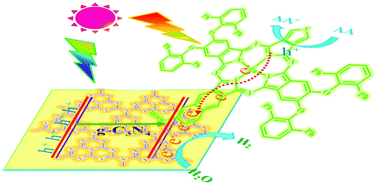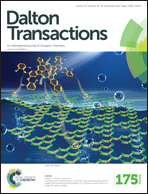Synthesis and characterization of an A2BC type phthalocyanine and its visible-light-responsive photocatalytic H2 production performance on graphitic carbon nitride†
Abstract
A highly asymmetric A2BC type zinc phthalocyanine (Zn-di-PcNcTh) has been designed and synthesized. The Zn-di-PcNcTh used a π electron rich thiophene ring in place of the benzenoid rings of phthalocyanine which acted as an electron donor, diphenylphenoxy substituents to retard aggregation and a carboxyl-naphthalene unit as an electron acceptor. The asymmetric phthalocyanine shows a strongly split Q-band and wide spectral absorption in the visible/near-IR light region, which can extend the spectral response region of graphitic carbon nitride (g-C3N4) from ∼450 nm to more than 800 nm. By using it as a sensitizer of 1.0 wt% Pt-loaded graphitic carbon nitride (g-C3N4), the experimental results indicate that Zn-di-PcNcTh-Pt/g-C3N4 shows a H2 production efficiency of 249 μmol h−1 with an impressive turnover number (TON) of 9960.8 h−1 under visible light (λ ≥ 420 nm) irradiation, much higher than that of pristine Pt/g-C3N4. Owing to the introduction of a highly bathochromic shift of 3,4-dicyanothiophene and the valuable “push–pull” effect from the thiophene (electron donor) to the carboxyl-naphthalene (electron acceptor) unit, Zn-di-PcNcTh/g-C3N4 gives an extremely high apparent quantum yield (AQY) of 2.44%, 3.05%, and 1.53% under 700, 730, and 800 nm monochromatic light irradiation, respectively, under optimized photocatalytic conditions.


 Please wait while we load your content...
Please wait while we load your content...